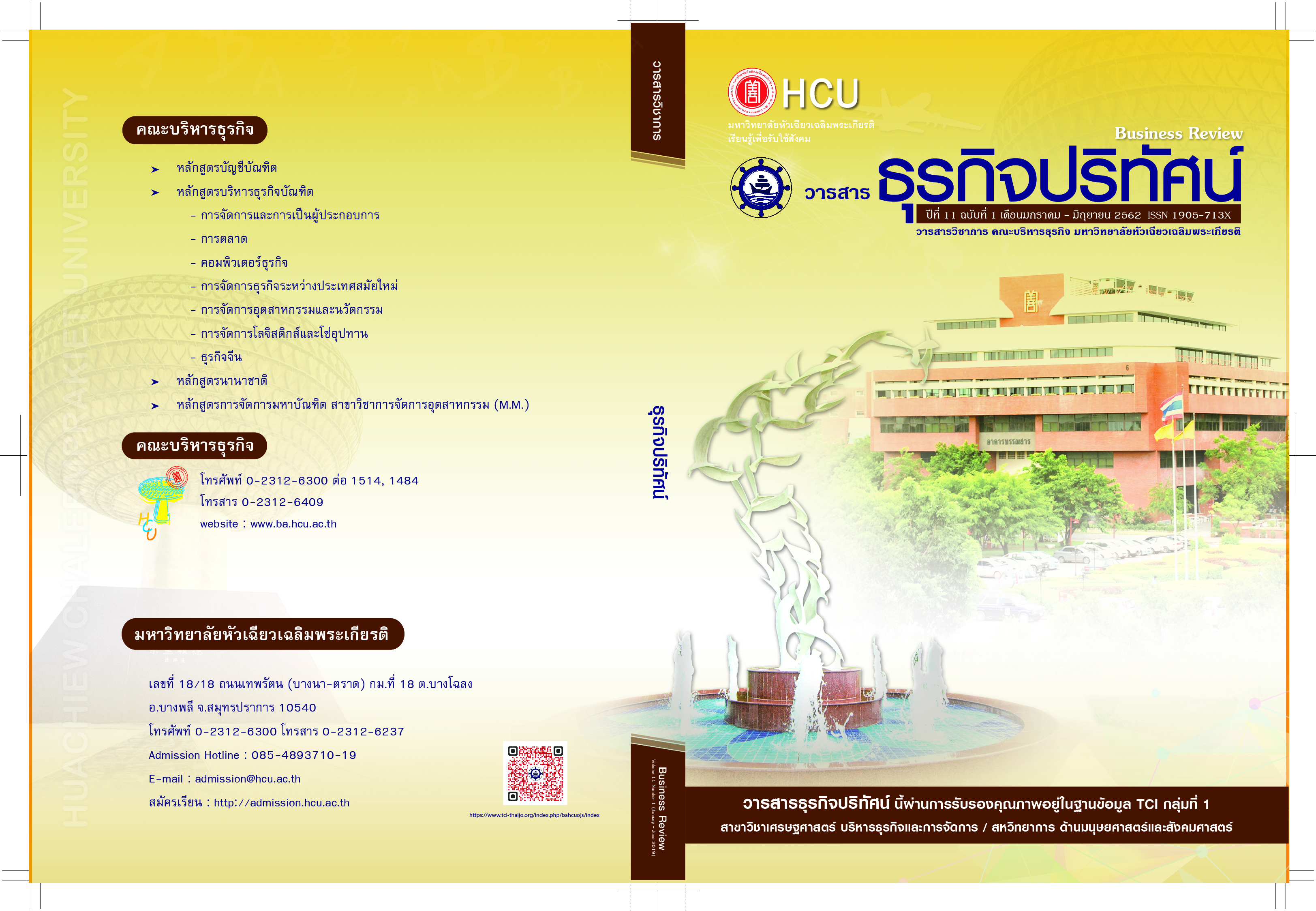The Development Guidelines for Human Capital of Operation Level Staff in Mice Industry
Keywords:
Development Guidelines, Human Capital, Operational Level Staff, MICE IndustryAbstract
The purpose of this research were to study the performance of operation level staffs
in the MICE industry by focusing on both current and required competencies of staffs in the
industry and analyzing the disagreement of competencies and exhibiting developing path
for these employees as noteworthy human resources. This research used a combination of
quantitative and qualitative methods. The instruments used questionnaire of 450 sent to sample
groups and stratified sampling method . For statistics: percentage, average and standard
deviation, were used. The other instrument was a set of semi-structured questions for 18 MICE
industry specialists in-depth interview verified by content analysis.
The results showed that the current core competencies of personnel at the operational
level in the MICE industry were moderate in all aspects. The performance that the entrepreneur
wants is high to very high . The highest disagreement of competencies is knowledge, followed
by attribute and skill. Human resource development guidelines show that the impact of the
development of education before working, especially in the teaching process is a very high
level while the impact of the development of contents is only at a high level. In the area of
human resource development, the impact of on-the-job training and seminars is at a high
level for staffs working. However, the impact of further study is at a moderate level for the
same working staffs.
References
เกรียงศักดิ์ เจริญวงศ์ศักดิ์.(2559).คนเก่งสร้างได้อารยโมเดลสมรรถนะSKL31220.กรุงเทพฯ: ซัคเซคมีเดีย.
เขมิกา สุภาษี . (2557). การพัฒนาพฤติกรรมการเรียนและผลสัมฤทธิ์ทางการเรียนของนักศึกษาในการ
เรียนวิชาการจัดแสดงสินค้าโดยการสอนแบบมีส่วนร่วม.วิจัยชั้นเรียน.วิทยาลัยเทคโนโลยี
โปลิเทคนิคลานนา เชียงใหม่ .
ชลลดา มงคลวนิช และรัตนาภรณ์ ชาติวงศ์. (2560). คุณลักษณะที่พึงประสงค์ของบุคลากรในอุตสาหกร
รมไมซ์. วารสารการจัดการ มหาวิทยาลัยวลัยลักษณ์, 6(2), 41-50.
ธำรงศักดิ์ คงคาสวัสดิ์.(2550). Competency ภาคปฏิบัติเขาท?ำกันอย่างไร?.พิมพ์ครั้งที่4. กรุงเทพมหานคร
: สมาคมส่งเสริมเทคโนโลยี (ไทย-ญี่ปุ่น).
นุช สัทธาฉัตรมงคลและอรรถพล ธรรมไพบูลย์.(2558).การศึกษาปัจจัยที่ส่งผลต่อการเป็นองค์การแห่ง
การเรียนรู้ของมหาวิทยาลัยเอกชนแห่งหนึ่ง.วารสารวิชาการธุรกิจปริทัศน์,7(1),167-183.
ยงยุทธ แฉล้มวงษ์. (2557). แรงงานไทยในบริบทใหม่:การเรียนสายอาชีพเพื่อชาติ.สถาบันวิจัยเพื่อการ พัฒนา
ประเทศไทย.สืบค้นเมื่อ 20 กุมภาพันธ์ 2559 เว็บไซต์: http://tdri.or.th/tdri-insight/thailabour-
force.
วิทยาลัยนวัตกรรม มหาวิทยาลัยธรรมศาสตร์.(2555). โครงการจัดท?ำแผนพัฒนาบริการท่องเที่ยวเพื่อรองรับ
การเปิดเสรีบริการท่องเที่ยว.กรุงเทพมหานคร: กรมการท่องเที่ยว กระทรวงการท่องเที่ยว
และกีฬา.
สไบทิพย์ มงคลนิมิตร์. (2554).การพัฒนาด้านทรัพยากรมนุษย์ด้านการบริการของโรงแรมแมนดารินโอ
เรียนเต็ล กรุงเทพฯ. วิทยานิพนธ์ปริญญามหาบัณฑิต, มหาวิทยาลัยศิลปากร.
ส�ำ นักงานส่งเสริมการจัดประชุมและนิทรรศการ.(2554). MICE Movement in Asia. สืบค้นเมื่อ 28
กุมภาพันธ์ 2559 เว็บไซต์: https://www.businesseventsthailand.com/fileadmin/ user_upload/
documents/mice-publications/Mice_Movement_in_Asia.pdf.
ส�ำ นักงานส่งเสริมสังคมแห่งการเรียนรู้และคุณภาพเยาวชน.(2558). “ส?ำรวจทุนมนุษย์ไทยเมื่อก้าวสู่ศักยภาพ
การแข่งขันหรือตัวฉุดรั้งการพัฒนา”.สืบค้นเมื่อ 24 ธันวาคม 2558 เว็บไซต์: http://www.
thaihealth.or.th/Content-fb/30200.
สุภางค์ จันทวานิช.(2556). การวิเคราะห์ข้อมูลในการวิจัยเชิงคุณภาพ.พิมพ์ครั้งที่ 21. กรุงเทพฯ:ส�ำ นักพิมพ์
แห่งจุฬาลงกรณ์มหาวิทยาลัย.
Bateman,S.T.,and Snell,A.S.(2009). Management : Leading&Collaborating in a Competitive World.
(8th ed.).Boston:McGraw Hill.
Boyatizis, R.E.(1982). The Competent Manager. New York: McGraw-Hill.
Creswell, J. (2009). Research design: Qualitative, quantitative, and mixedmethod Approaches. (3rd ed.).
California: Sage.
Fenich, G.G. (2008). Meetings, Expositions, Events, and Conventions : An Introduction to the Industry.
Upper Saddle River,NJ:Pearson-Prentice Hall.
Huang,Y-L., and Lin,C-T.(2010). Management Trainee Core Competencies in the Hospitality Industry:
Differences Between Managers and Scholars. Journal of Human Resources in Hospitality
& Tourism,10(1),1-13.
Hui-Wen,V.T.(2014). Constructing acompetence model for international professionals in the MICE
industry : Ananalytic hierarchy process approach. Journal of Hospitality. Leisure ,Sport
&Tourism Education,15,34–49.
Kim, S.S., Chon, K., and Chung, K. (2003).“Convention industry in South Korea: an economic impact
analysis”.Tourism Management,24(5),533-41.
McClelland,D.C. (1973).Testing for Competence rather than Intelligence. American Psychologist,28,1-14.
Mondy, R. W., and Noe, R. M. (2005). Human Resource Management. Upper Saddle River, NJ:
Pearson Prentice-Hall.
Nadler, L., and Nadler,Z.(1992). Developing human resource. San Francisco: Jossey-Bass..
Pi-feng Hsieh. (2013). Curriculum planning of MICE course in continuing education. Journal of
Hospitality. Leisure ,Sport &Tourism Education,13,107-122 Schultz, T. W. (1961).
Investment in human capital. The American Economic Review. Jstor,51(1),1-17.
Shariff N. M. et al.(2014). Tourism and Hospitality Graduates Competencies : Industry Perceptions and
Expectations in the Malaysian Perspectives. World Applied Sciences Journal,31(11),1992-2000.
Spencer, L.M., and Spencer, S.M. (1993).Competence at work: Models for Superiors Performance.
New York: John Wiley & Sons.
Thailand convention and Exhibition Bureau. (2012). Introduction to MICE Industry. Thailand :Thailand
Convention and Exhibition Bureau.
Vance, C. M., Sibeck, G., McNulty, Y., and Hogenauer,A. (2011). Building global competencies through
experiential coursework in international travel and tourism. Journal of International
Education in Business,4(1),30–41.
Downloads
Published
How to Cite
Issue
Section
License
All articles published in the Business Administration and Management Journal Review are copyrighted by the journal.
The views and opinions expressed in each article are solely those of the individual authors and do not represent those of Huachiew Chalermprakiet University or any other faculty members. Each author is fully responsible for the content of their own article. Any errors or issues found are the sole responsibility of the respective author.




